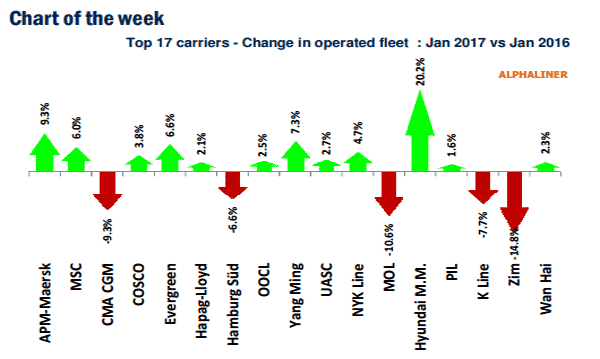As SCDigest recently reported, 2016 may have been the most tumultuous 12 months in the 60 year history of the container shipping sector, with the level and pace of alliance forming, mergers, acquisitions, failures, and restructurings among carriers perhaps unprecedented. (See 2016 a Year of Tumult in the Ocean Container Sector, but will Changes at Last Drives Rates Higher for Shippers in 2017?)
Of course, all this largely driven by rock bottom rates in 2016, as trade and container volumes grew yet again at a barely positive pace, and new megaships having been delivered in recent years in expectation of much high volume growth.
Supply Chain Digest Says... |
 |
"Carriers have taken a lot of capacity out of the market, they are losing significant sums of money every day, and continuing to do that is just simply not sustainable."
Soren Skou
Maersk Line |
 |
What do you say? |
| Click here to send us your comments |
 |
| Click here to see reader feedback |
|
|
Those dynamics are sure to continue in 2017, though there are signs the industry is getting serious about overcapacity.
According to the analysts at Alphaliner, only 17 large scale international container carriers remain as of January 2017, down from 20 one year ago.
The reduction results from the acquisition of APL by CMA CGM and the integration of CSCL within COSCO, while Hanjin Shipping made an abrupt exit from the container shipping market in September 2016 due to bankruptcy.
The number of carriers will shrink further in 2017 with the pending conclusion of the Hapag-Lloyd and UASC merger, the acquisition of Hamburg Sϋd by Maersk, and the merger of K Line, MOL and NYK's liner shipping businesses. That would leave just 13 major carriers, before any other moves.
The overall capacity operated by the 17 main carriers shrank by 1.3% over the last 12 months, after taking into account the removal of Hanjin's tonnage, Alphaliner adds. Collectively, these carriers control 81.2% of the global liner capacity as at 1 January 2017, compared to 83.7% controlled by the 20 main carriers a year ago.
Apart from Hanjin Shipping, five other carriers logged capacity reductions, with Zim recording the largest loss as its operated capacity shrank by 14.8%. MOL and K Line also recorded significant capacity reductions of 10.6% and 7.7% respectively ahead of the planned merger with NYK to form the J-3 partnership.
Although CMA CGM Group's operated capacity grew by 17.3% thanks to the APL purchase, the aggregated capacity of both carriers fell by 9.3%, due mainly to the outsourcing of a substantial part of CMA CGM's feedering activities (smaller ships that feed containers to larger ships or move containers from terminal to terminal within a port complex).
Hamburg Sϋd was also forced to rationalize its operated capacity due to the very weak trading conditions on its core South America routes. The carrier's operated fleet shrunk by 6.6% last year, ahead of the Maersk acquisition.
The year over year change in TEU capacity across the 17 major carriers left is shown in the graphic below from Alphaliner. (We'll note the big jump in capacity by Hyundai Merchant Marine comes from it picking up some of the assets from bankrupt Hanjin.)

Separately. Maersk Line CEO Soren Skou estimates the total idled container ship capacity is currently about 5%, but that even that relatively small reduction is at last acting to prop up rates.
(See More Below)
|
CATEGORY SPONSOR: SOFTEON |
|
|
| |
|
|
He noted in an interview with CNBC that "Carriers have taken a lot of capacity out of the market, they are losing significant sums of money every day, and continuing to do that is just simply not sustainable."
Before the financial crisis, global trade was growing 8-10% per year, Skou said.
“Now we're down to something very close to global GDP, around 2% probably in 2016. We expect 2.5%, maybe 3% this year. So of course it's a lot lower level of growth, that means that we have overcapacity, have invested in too much capacity as an industry, we are working our way through that as we speak, and we have seen virtually no new capacity being ordered in the last year,” Skou added.
Will the carriers maintain discipline and send rates back higher? The answer appears to be Yes, for financial survival if nothing else, though many wild cards remain. Will global trade rally and move past 3% this year, or will protectionism drive down volumes below Skou's forecast?
We will keep you posted.
What's your take on developments in the container shipping industry? What do you think will happen to capacity and/or rates in 2017? Let us know your thoughts at the Feedback section below.
Your Comments/Feedback
|